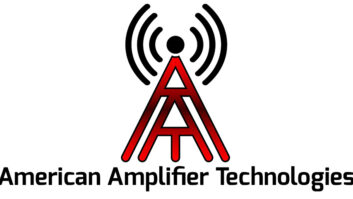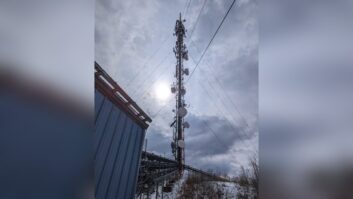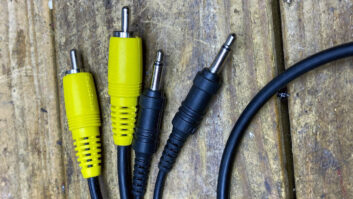There’s a hidden gem on eBay and Amazon: the Yuanjing 6N11 headphone amplifier.
Out of the box it’s OK, maybe even above average. With a few modifications, it becomes a really great-sounding headphone or line driver amplifier. When I say great, think thousand-dollar amplifier, near-stereophile Class A quality.
It has many uses, in and outside a broadcast facility. You can use it as a known reference amplifier when comparing the sound of different sources and/or stations. Many (including me) believe that putting a tube before a streaming encoder improves the fidelity of the stream due to the subtle harmonic structure unique to a tube when operated with very low feedback.
The basic amplifier costs between $30 and $40; and you need to buy a 24 V, 1-amp power supply, which will put you out another $10 to $12. The modifications are not difficult and they need not all be done all at once — you can do one, listen to the difference and then do the next one at your leisure. If you do all of them at once, it will take no more than a few hours.
RETRO
The basic amplifier is a tube/MOSFET hybrid, running Class A with no global feedback and only a very small amount of local feedback on the tube due to the cathode resistor (in this case, they are single turn pots that are used to center the output bias voltage) and the fact that a triode amplifier inverts the signal. The MOSFET also runs Class A and actually gets quite hot, so both it and the LM317 regulators (configured as constant current sources) have heat sinks on them (one of the mods is to put heatsink compound on at least the MOSFETs).
If you search on eBay, you’ll find many types of these amplifiers there. I chose this model for the following reasons: First, it is one of the least expensive. Second, it is a simple design; when high-quality audio is concerned, less truly is more. Third, it is readily available.
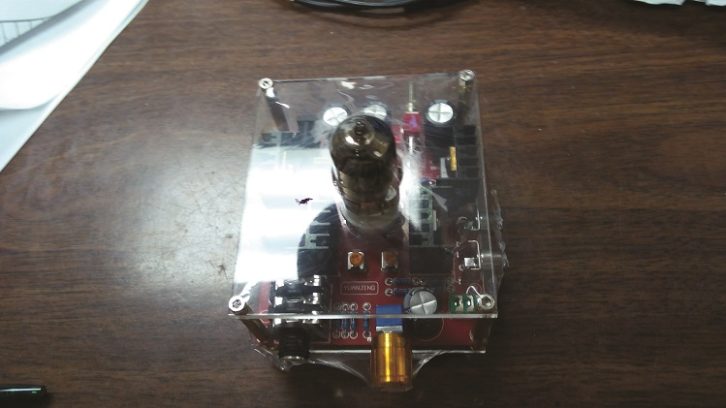
To find it, search “YJ 6N11 Tube headphone Amplifier” on Amazon.com or eBay.com. Several models should appear with prices in the $30–$40 range, mostly shipped free from China. As I write this, the prices on eBay varied from $32 to $35 (the latter came with its 24 V adapter), while Amazon’s price was $39.99. The AC adapter is a common large bayonet plug switching adapter that provides 24 volts at one amp or higher. They typically sell for under $10 at either place.
Fig. 1 shows the amplifier with its red circuit board, encased in clear Lucite plastic with the tube sticking out of a hole in the top. It looks rather “retro” in design.
While waiting for the amp to arrive (which can take anywhere from a few days to a few weeks), you can buy the parts that necessary for the modifications. Most of the parts can be bought at Radio Shack. I’ve included the Radio Shack reference numbers for your convenience. You will need:
• Qty 2 — 0.1 μF metal film capacitors (RS# 2721053)
• Qty 3 — 3.5 watt, 330 ohm resistors (or equivalent — we need a 100 ohm 1 watt resistor) (RS# 271113)
• Qty 1 — Heat sink compound (RS# 2761372)
• Qty 1 — 470 μF 25 volt or higher electrolytic capacitor (either axial or radial will do) (RS# 2721018)
• Qty 2 — IRF 510 MOSFET (RS# 2762072)
• Qty 2 — 0.1 μF Metallized Polyester Film Capacitor (RS# 2721053)
• Qty 1 — 12AU7 tube (see text)
• Miscellaneous: About one foot of 20-gauge or larger hook up wire (18-gauge solid is ideal)
• Four #8 nuts
When you first get the amplifier, hook it up and listen to it for a few days. This will give you a baseline to how the stock unit sounds.
CAUTION! Power up the amp for about a minute before plugging in your headphones, and unplug your headphones before powering down the amplifier. Doing so will avoid a large turn-on transient from possibly damaging your headphones and your hearing!
To me, the stock unit sounds “OK” with a slightly rubbery bass, clear but not clean mid-range, with softened highs that have little or no “bite.” The separation could also be better — I’ll explain why in the circuit description.
This amp is a simple and fairly clever design. It uses a 6N11 dual triode tube (also known as a 6DJ8) run in what’s known as a “starved plate zero bias mode.” This means that its plate voltage is the 24 V supply and there is no bias voltage applied to the tube grids. Essentially the tube is conducting current at all times (class A mode). The tube provides all the necessary amplification (gain). The MOSFETS serve as a single-ended impedance converter (a source follower), which converts the high impedance tube plate to the lower impedance of the headphones. They also run in Class A mode and have no negative feedback. Their gain is slightly less than 1. The tube and MOSFETs are powered by a pair of LM317 regulators configured as constant current sources. The tube filament voltage is derived by the two LM317s both pulling current through it. One side of the tube filament is grounded and the other side sources the two LM317s.
This is a clever design, but it has a fault: The channel separation is degraded by the resistance of the tube filament. This is why the unit’s stereo separation is “meh.” We fix this in a very simple way: by putting an electrolytic capacitor across the tube filament. This shunts the audio across the filament to ground, while allowing the DC to still power the filament. I used a 470 μF 25 V capacitor. Radio Shack has one small enough to fit under the circuit board, which is where I put my parts — and using the #8 nuts to give a bit more space for the components.
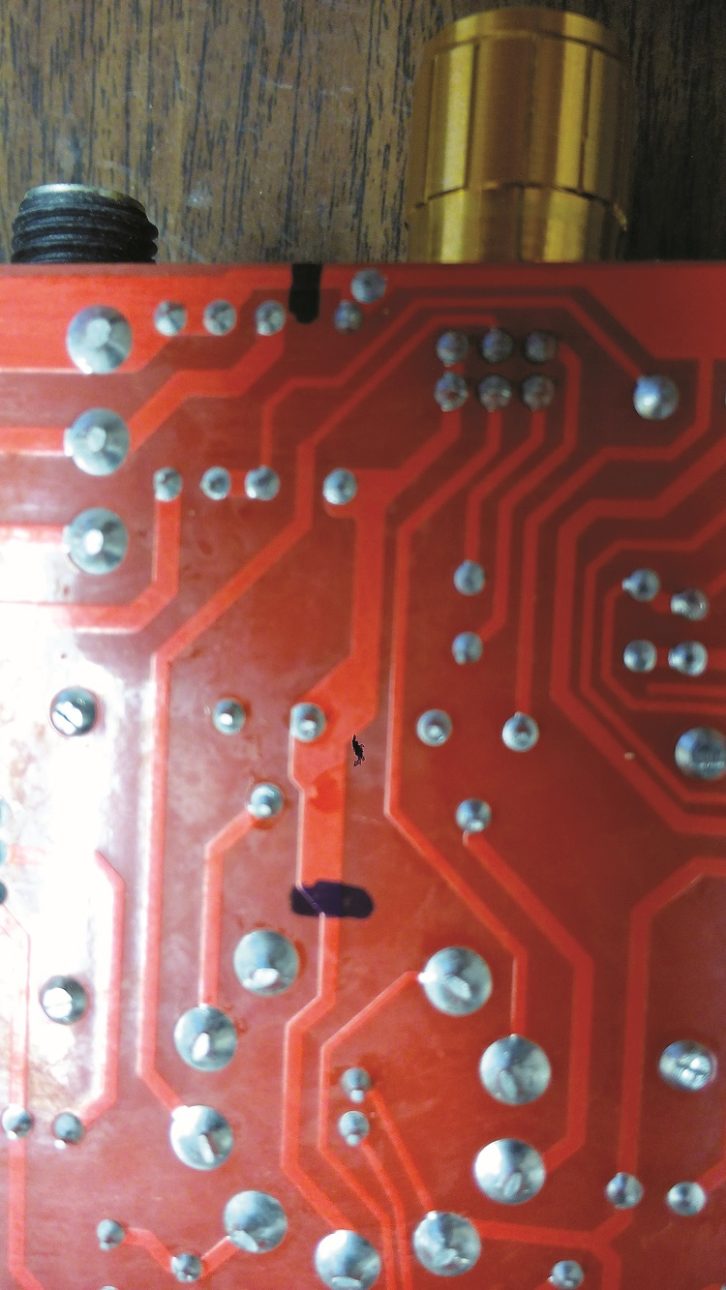
WHY THE NEW TUBE?
Though originally designed as an RF amplifier tube in color TV sets, the 6N11/6DJ8 is a legendary audio tube that is used in many high-quality preamps. It was also used by Tektronix and Hewlett-Packard in their vacuum tube oscilloscopes. It is a truly great tube — as long as it is run at a plate voltage of 130 volts or higher. At lower voltages, it simply does not sound as good as a 12AU7. Also, the Chinese-made 6DJ8s (known as 6N11s) are, to put it mildly, junk. Fortunately, converting to the 12AU7 is easy.
Ready? Great, let’s get started!
1: FIX THE GROUNDS!
The grounds in this unit are poorly done. Looking at the bottom of the circuit board, if you trace the circuit from the power jack, it goes in two directions: To the left are all the filter capacitors, meaning that the load is pulled away from these. As you go around the perimeter of board to the right, the first connection is the ground of the headphone jack, which by itself would be OK, except following that are all the other grounds. Next, the trace narrows significantly (the area between the headphone jack and the volume control). At its narrowest point there is a zero ohm resistor that connects to the bottom of the volume control and the tube filament, which itself powers the rest of the amplifier via the two LM317 current sources. So you have the largest amount of power drawn from the smallest part of the circuit ground.
Where I come from, they call this a fuse! Finally, the ground goes to the input jacks, meaning that the lowest level point in the entire circuit is at the end of the ground system.
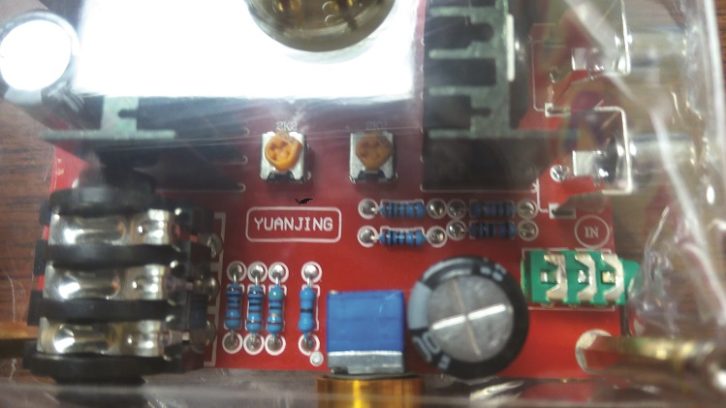
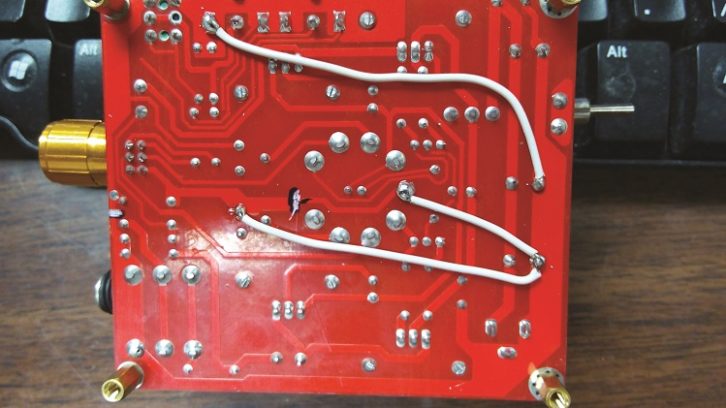
We start by cutting the traces of the circuit board where the blue magic marker marks are, see Fig. 2. Make sure that you cut through the traces completely. You can use an awl, X-Acto blade or even a “greenie” screwdriver to do this. Remove the zero ohm resistor from the circuit by cutting one lead. This resistor is the just to the left of the volume control, with a single black stripe upon it, see Fig. 3. Next, install the three jumper wires as shown on Fig. 4. It’s important to route the top wire as shown.
Once you have this done, you can put the amp back together if you want and have a listen. What I heard before was that the volume control would not silence the audio (a small amount always bled through). Now it does. The bass also gets a bit better.
2: PUT FILMS ACROSS THE OUTPUT CAPACITORS!
Since this amplifier uses a single polarity power supply, there is an output coupling capacitor to block the DC bias from going into your headphones. The amp as it comes uses an excellent Nichicon 1000 μF electrolytic capacitor for this purpose, but I like to bypass large value electrolytics with small value metal film capacitors. I used some 0.22 μF capacitors that I already had, but the 0.1 μF capacitors available from Radio Shack are also excellent. Put the metal film capacitors on your table, label side up, and then make sure that the leads on the left go to the minus terminal of the electrolytic. The two amp output capacitors are located next to the volume control and behind the output jack. In Fig. 5 you’ll see my two green 0.22 μF capacitors. Notice that one of the capacitors is “label side down” — this was done to connect the capacitor to the minus terminal. Adding these capacitors makes the highs sound better. Doing this mod will possibly result in the part not clearing the bottom plastic cover; the way to fix this is to put four #8 nuts in between the four brass studs and the circuit board. Be careful to not strip the threads on the studs.
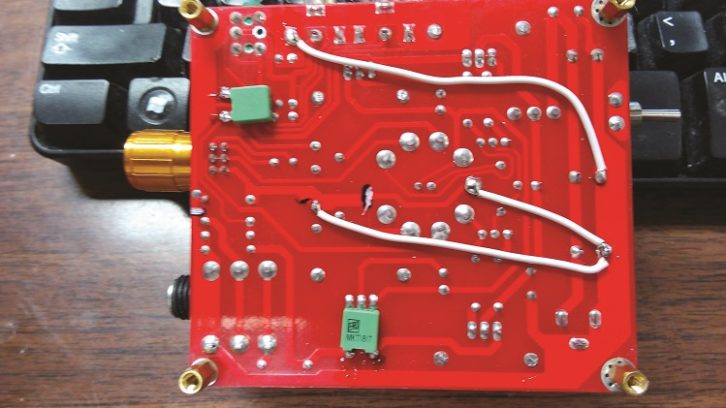
3: REPLACE THE MOSFETS!
The MOSFETS used in this amplifier are IRF630s and were installed because of their low cost. Unfortunately, they have a fairly high gate capacitance. The IRF510 is a much better device and is pin-compatible with the existing part.
Be careful when removing the devices — use a solder sucker or solder wick and make sure the holes are clear before putting in the new devices (see why I told you to route the wire above the way that I did?). If you don’t know how to do this, have someone who does replace the parts for you. You should also put heat sink compound in between the part and its heat sink.
After you replace the MOSFETS, you should reset the bias voltage. This is done by powering the unit up for about 5 minutes without a headphone plugged in, then putting a DVM meter between the plus terminal of each output capacitor and ground, while setting the two bias pots for exactly 12 volts. The two adjustments will interact slightly, so go back and forth a couple of times. While not absolutely necessary, centering this bias voltage at half the power supply makes sure that the amplifier clips symmetrically. Doing this mod will improve both the bass and highs.
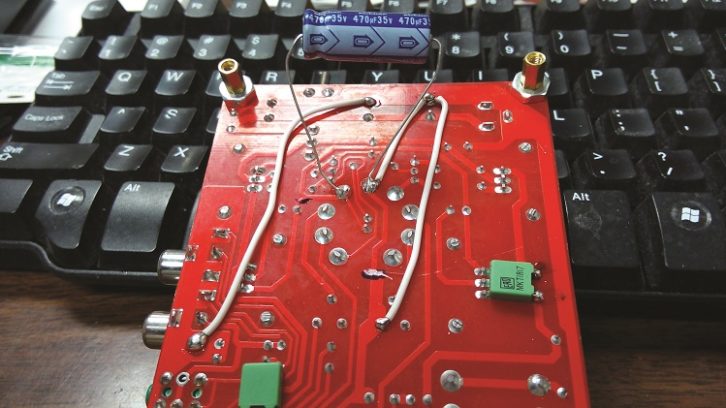
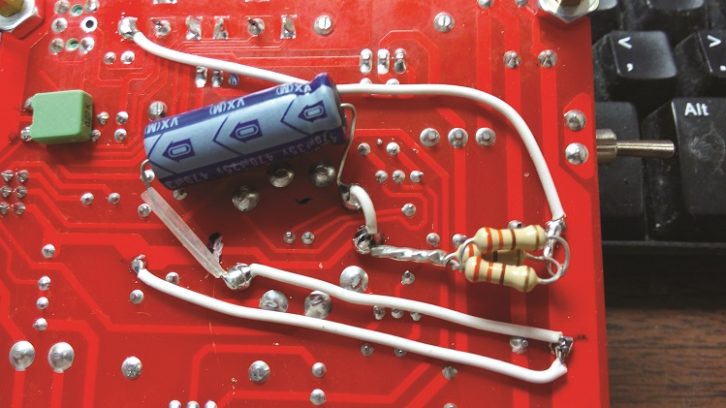
4: INSTALL THE ELECTROLYTIC CAPACITOR!
The electrolytic capacitor goes across the tube filament. Its purpose is to increase stereo separation by AC-bypassing the common point of the two channels to ground. You install the capacitor between Pins 4 and 5 of the tube… if you plan to keep using a 6N11 or 6DJ8 tube! If you are changing the tube, leave this step until after the tube-change step below. See Fig. 6 (here we’re using the 6DJ8 tube). Capacitor “minus” goes to ground (Pin 5) and “plus” to Pin 4. I have tacked the capacitor in to illustrate how it would be connected — you should, of course, trim the leads. Also notice that I have installed the #8 nuts — by doing this the capacitor will fit under the circuit board.
5: REPLACE THE TUBE!
This step actually requires removing one jumper. The jumper that goes from Pin 5 of the tube is removed and a jumper is installed from Pin 9 of the tube socket (currently no connection) to ground. A small jumper is connected between Pins 4 and 5 of the tube socket. Notice that this jumper is elevated because two traces pass between the two tube pins. Connect the negative of the electrolytic capacitor to Pin 9 and its positive to Pin 4 of the tube socket. Finally, put the three 330 ohm half-watt resistors in parallel and tie them in between Pins 9 and 5 of the tube socket. See Fig. 7.
Two important things: First I used clear insulating tubing on the capacitors negative lead and one of the resistor’s leads and I also “cheated” by connecting the resistors between Pin 5 of the tube socket and ground (remember Pin 9 is already connected to ground). The reason we are making this modification is that though the 12AU7 also uses Pins 4 and 5 for its filament, it has a 12-volt one as opposed to the 6-volt one of the 6N11. However, there is also a center tap on the filament, which is brought out of the tube on Pin 9, so by wiring things as we have we are putting two 6-volt filaments in parallel. The purpose for the resistors is because the filament characteristics between the 12AU7 and 6N11 are slightly different and the resistors put the filament voltage back in the 12AU7’s range.
When replacing the tube you should also reset the bias voltages back to 12 volts (see Step 3 above).
PREPARE TO BE AMAZED!
How does the completed amplifier sound? In a single word: amazing! Unless you are used to the sound of expensive hi-fi components, I can confidently state that you have never heard sound this good before. The bass is perfect, mids are crystal clear and highs simply have a sparkle. Separation ‘glides’ easily from channel to channel.
I guarantee that you will be happy with this amplifier!
POSTSCRIPT: “ROLL YOUR OWN”
“Roll your own” folks are people who try different tube types in their amplifiers to customize the sound to their exact liking. There are many variants of 12AU7 (5814, ECC82) tubes — and these tubes were made by dozens of manufacturers worldwide, each with their own unique manufacturing style. 12AT7 tubes will also work in this unit, so there are a lot of possibilities. Just remember to rebias when you change tubes.
I hope that you enjoy your new super-fi amplifier.
Dana Puopolo is chief engineer at WGLS(FM), Rowan University in Glassboro, N.J.
